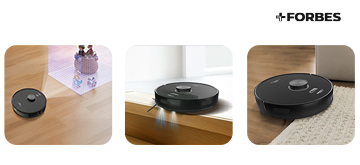
Addressing Common Issues with Robot Vacuums and Their Solutions
PUBLISHED ON: 27-Mar-2025
Robot vacuums have transformed home cleaning, making daily maintenance effortless and efficient. These smart devices navigate your floors, tackling dust, pet hair, and debris with minimal effort from you. However, like any appliance, they can run into issues that affect their performance. From connectivity problems to reduced suction power, these challenges can disrupt your cleaning routine.
Understanding these common problems and their solutions can help you keep your robotic vacuum cleaner in top shape. In this blog, we’ll explore troubleshooting tips to ensure smooth operation, all while considering the vacuum cleaner price and selecting the best vacuum cleaner for home use.
Understanding Common Problems in Robotic Vacuum Cleaners
Robot vacuum cleaner users report issues such as erratic navigation, difficulty overcoming obstacles, and diminished suction power. These challenges are often linked to sensor malfunctions, obstructed brushes, or battery issues that hinder proper performance. By identifying the underlying causes, you can implement simple maintenance routines that restore the vacuum’s efficiency.
Solutions to Navigation and Mobility Problems
One of the most prevalent issues is poor navigation. Over time, dust and debris can accumulate on the sensors—such as infrared and anti-collision —that guide the device. This can lead to erratic movements or the vacuum getting stuck under furniture.
To resolve these issues, ensure that:
- Sensors are regularly cleaned: Use a soft cloth to remove dust and smudges from infrared sensors and bumper pads. This simple maintenance step allows the vacuum to maintain accurate room mapping.
- Wheels are free of debris: Check the universal and side wheels for any obstructions that might hinder movement. Removing tangled hair or small particles can significantly improve mobility.
By addressing these factors, many users have observed enhanced performance in their robotic vacuum cleaner, ensuring a smoother cleaning cycle.
Enhancing Suction Power and Cleaning Efficiency
Another common challenge in automatic vacuum cleaner is reduced suction power, which directly affects the cleaning efficiency of your vacuum. This problem often arises when filters become clogged, or the brush mechanism is obstructed by pet hair or dust.
To enhance suction and cleaning efficiency:
- Regularly clean brushes and filters: Remove and wash the HEPA and primary filters as specified in your user manual. A clean filter not only improves suction but also maintains air quality.
- Empty the dustbin frequently: Overfilling the dustbin can impede suction performance. Ensure you empty it as soon as it reaches capacity.
- Inspect the suction passage: Debris accumulation within the suction channels can reduce airflow. Periodically checking and clearing these passages is essential for optimal performance.
These simple yet effective steps can help restore the original suction power of your device, making it one of the most efficient robot vacuum cleaner in the long run.
Choosing the Right Robotic Vacuum Cleaner
When selecting a device, several factors should be considered to ensure you get the most value out of your investment, especially when balancing functionality and automatic vacuum cleaner cost. Features such as advanced navigation, battery longevity, and ease of maintenance are crucial.
Forbes' vacuum cleaners stand out in this regard. Here are two models that address common issues while offering top-notch performance:
- Forbes L-Vac Voice Nuo: This model integrates advanced sensor technology and boasts 3S Mopping Technology for quiet and thorough cleaning. It comes with Lidar 2.0, Smart ODAC and anti-fall technology that ensures smooth navigation around obstacles. Furthermore, its voice command compatibility with Alexa and Google Assistant allows users to control cleaning modes, schedule sessions, and direct the vacuum with simple voice prompts. With a robust 5200 mAh battery providing up to 180 minutes of runtime, this device addresses many of the common issues associated with reduced mobility and battery performance.
Forbes Robo Vac N Mop: This automatic vacuum cleaner comes with several practical features, including GYRO 2.0 Navigation Technology, which ensures efficient cleaning by navigating through your home. With Customisable Clean Assist, users can schedule rooms, set cleaning sequences, select specific areas, and choose convenient cleaning times. It also boasts powerful 2700 Pa suction and a 3200mAh battery, enabling up to 3 hours of cleaning in quiet mode.
The 3S Mopping feature is suitable for various floor types, offering smart, scratch-free, and silent mopping levels. The Pet-Friendly Design effectively picks up pet fur and dander. Advanced Safety Features like anti-collision and anti-fall sensors ensure safe operation. The High-Efficiency Filtration system with HEPA captures dust, allergens, and pet dander, improving air quality. Lastly, Voice Assist Compatibility allows integration with Amazon Alexa and Google Assistant for hands-free control.
When comparing vacuum cleaner prices with features, the Forbes’ robotic vacuum cleaners start from INR 16,999 to 25,500, making them a smart investment for any home.
Conclusion
Regular maintenance helps resolve common robot vacuum issues. Cleaning sensors, brushes, and filters, checking for issues such as battery and other battery or charging ensures smooth operation.
When choosing a model, consider the vacuum cleaner price, features, and the best option for home use. Investing wisely ensures better performance, durability, and longevity.
Forbes’ range, including the Forbes L Vac Voice Nuo and Forbes Robo Vac N Mop, offers advanced features, reliability, and strong suction power. These models demonstrate how thoughtful design, and engineering can address common challenges, providing an efficient and hassle-free cleaning experience for long-term satisfaction.
